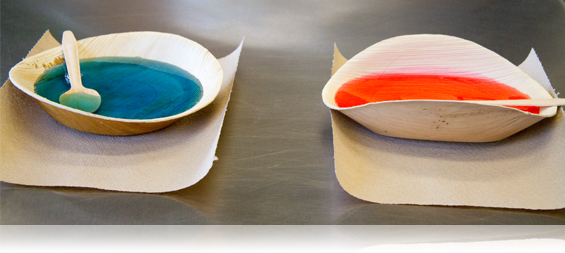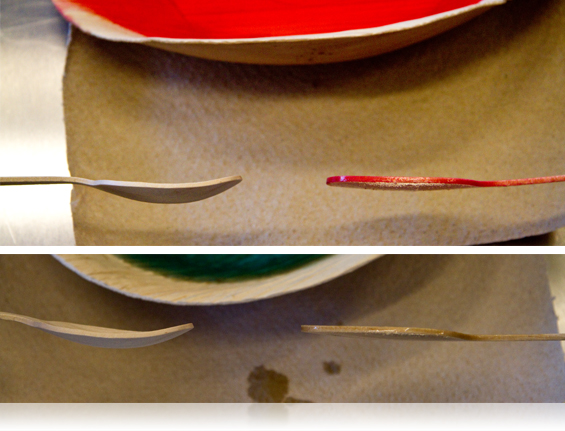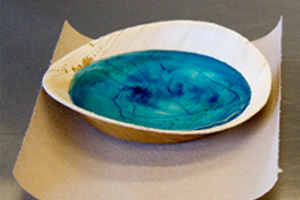We have been asked if our palm leaf bowls and plates will leak if they are filled with liquid, so we put this question to the test and performed an experiment in our kitchen.
We did a side-by-side comparison of palm leaf bowls filled with hot water and cold water so you’ll know what to expect if your bowl is filled with hot soup, gazpacho, or ice cream. But we weren’t just testing the durability of the bowls, we were also testing the durability of our birchwood spoons. We put spoons in each bowl to test how long they would last before they became saturated with water & unusable.
The results of our test revealed that the maximum amount of time recommended for liquids to sit in the palm leaf bowls is 2 1/2 hours. However, hot liquids (the water we used for the hot liquid test was VERY hot – near boiling) can warp the shape of the plate and will soak into the plate and any utensils faster than if cold liquid is used. We’d set the maximum time for a hot liquid to sit in a palm leaf bowl at around 1 1/2 hours.
However, neither the hot water bowl nor the cold water bowl leaked. So, while these plates will become soggy over time, we can happily report that they won’t leak.
To see the full timeline of the test, continue reading below:
9:15am – the test begins. Hot water (dyed red) is poured in one bowl and cold water (dyed blue) is poured in another. Spoons are inserted.

9:30am – the hot water bowl is starting to warp slightly from the hot temperature. The cold water bowl is maintaining shape. Spoons are still very strong and have not warped. Neither bowl is leaking.
9:45am – the hot water bowl has now warped into a different shape and does not look like its counterpart. The cold water bowl is still very rigid and maintaining its shape. Both spoons are still very rigid and not soggy. Neither bowl is leaking.
10am – the hot water bowl is maintaining its new shape, but is starting to feel a bit soft on the sides. The cold water bowl is very stiff and the shape is the same. Both spoons are still strong, but the spoon in the hot water bowl is starting to warp. Neither bowl is leaking.
10:15am – the hot water bowl is still the same shape, the sides of the bowl have the same amount of softness/give as the 10am check. The spoon in the hot water bowl is starting to give a bit, but still intact. The cold water bowl is still the same shape and still rigid. The spoon is starting to be a bit more pliable.
10:30am – the hot water bowl is in the same condition as the previous check. The spoon is becoming fairly pliable and is starting to flatten out and lose its spoon shape. The cold water bowl is still the same shape, the sides are starting to soften slightly. Neither bowl is leaking.
10:45am – the hot water bowl seems to have warped a bit more (with the sides curling up). The bowl is softening on the sides and on the bottom. The spoon is pliable, bending when tested, and has flattened out. The cold water bowl is rigid still and the spoon is becoming pliable, but is still rigid overall. Neither bowl is leaking.
11am – the hot water bowl seems permanently warped now and the spoon has flattened completely. The spoon is no longer usable as spoon, it is a flat surface. The cold water bowl is maintaining its shape, softening at the sides and the bottom. The cold water spoon is beginning to flatten and absorb moisture. Neither bowl is leaking.
11:15am – the hot water bowl is now what we consider soggy. The spoon is very flat, more like a shovel than a spoon. The cold water bowl is not soggy, but the sides are soft. The spoon is still rigid, but it has also flattened.
11:30am – the hot water bowl is very soggy and the spoon is very soft. The cold water bowl is starting to become soggy and the spoon is very flat. The hot water bowl has warped to the point that the water is nearing the point of spilling on the side. However, neither bowl is leaking.

11:45am – OUR FINAL CHECK. The hot water bowl is almost spilling, it is very squishy and soggy. The spoon is now saturated with water and has lost its strength. The cold water bowl is soggy on the sides and soft on the bottom, but still holding its general shape. The spoon is fairly flat, there is a tiny curve left to it and it is slightly water-logged, but still stronger than the hot water spoon.
To see how the spoons fared, check out the pictures below comparing the spoons that sat in the hot & cold water to a dry spoon.

As you can see above, by the end of the test, the spoons had lost their curve and would no longer be able to carry a spoonful of soup or other liquid from the bowl to your mouth.
To be more specific: after about 1 to 1 1/2 hours of sitting in liquid (slightly longer for cold liquid than for hot), the spoons will flatten, and after 2 1/2 hours, the spoons will completely lose their shape and absorb enough water to make them pliable.
We hope this test answers your questions about how durable (and non-leaky!) these palm plates and birchwood cutlery are, but if you have any more questions, we’ll be happy to test them further.
___________
Browse More:
Palm Plate Information



Comments 1
What a detailed review and test! I’ve seen these palm plates at festivals and shows, they look great but always wondered how they held up! Thanks for sharing!